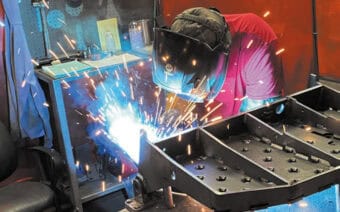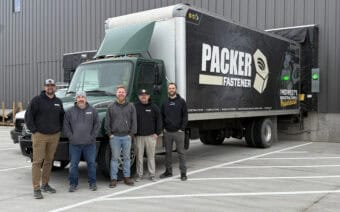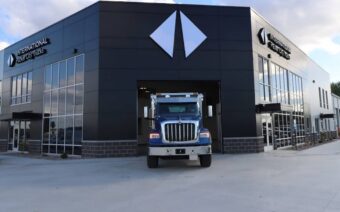
August 25, 2025
The concept of Industry 4.0 as connected systems, real-time data and continuous process improvement has been on the table for more than a decade.
The vision is compelling.
But as Buckley Brinkman, CEO of the Wisconsin Center for Manufacturing & Productivity (WCMP), put it in a conversation, the last 10 years of engagement have often been “complicated, fuzzy and unproductive.”
A big reason is that the early approach to Industry 4.0 asked too much, too soon.
Many manufacturers were told the goal was to orchestrate five, 10 or even 15 discrete technologies into a unified transformation program.
For most small- and mid-sized manufacturers, that simply wasn’t realistic.
Buckley explained that nobody has the time to learn everything first and then determine ROI.
Without mature standard operating procedures (SOPs) and a solid technology foundation, these big orchestration efforts stalled before they could deliver results.
The 2025 Wisconsin Manufacturing Report confirms this reality in numbers.
Workforce shortages, thin margins and uncertainty over ROI remain the top friction points.
Security concerns and a shortage of hybrid OT/IT talent add to the headwinds.
Yet, as the report also shows, belief in the value of Industry 4.0 hasn’t diminished.
It’s the execution that has lagged.
The frictions that keep slowing progress
The barriers to adoption fall into two broad categories: operational constraints and organizational culture – both have deep roots.
There is also an ancillary consultant factor to discuss.
Operational constraints start with the physical plant.
Many Wisconsin manufacturers are still running production on control systems that were installed decades ago.
These systems work, but they don’t connect easily to modern monitoring or analytics platforms.
Integration can require expensive, low-return custom work just to get a data feed going.
That’s a hard sell for leadership, especially when margins are already thin.
Then there’s the skills gap.
The 2025 WCMP report again puts workforce issues at the top of the list, with “finding and keeping qualified employees” rated as the single most important challenge.
The talent pool for people who understand both operational processes and modern IT systems is limited.
Companies often must choose between pulling an experienced plant manager into a tech project (slowing production in the process) or bringing in outside help that doesn’t fully grasp the shop floor’s reality.
This gap feeds directly into ROI uncertainty.
For many SMBs, the leadership team doesn’t have the time or resources to thoroughly evaluate every new technology, and making the wrong choice could drain resources needed for day-to-day stability.
The WCMP data shows that though most manufacturers are optimistic about their own operations, capital expenditure plans remain cautious, especially among smaller firms.
Margin pressure compounds this caution.
In competitive or commodity-driven markets, profits may not allow for the kind of multi-year commitments often baked into consultant proposals.
Even if the leadership team believes in the benefits of automation, the risk of running out of financial runway mid-project is enough to slow or stop the decision entirely.
And, increasingly, security is part of the calculation.
Connecting operational technology to broader networks creates new attack surfaces, and nearly one in five Wisconsin manufacturers has experienced a cyber incident in recent years.
In regulated industries, compliance risks add yet another layer of complexity.
Organizational and cultural barriers, beyond the technical and financial realities, human factors play a significant role.
Change fatigue is common.
Many employees have seen waves of initiatives that didn’t deliver clear, lasting benefits.
That history breeds skepticism.
There’s also a cultural element.
In some shops, automation is perceived as a threat to the skill and pride of human craftsmanship.
In others, there’s simple control anxiety, which is a reluctance to hand over decision-making to systems that leadership doesn’t fully understand.
The relationship between IT and operations can create tension, too.
IT project timelines and the realities of production schedules don’t always align, and when they clash, plant floor priorities usually win.
Finally, the way many SMBs handle IT creates a subtle but important blind spot.
Outsourced IT providers keep systems running but aren’t embedded enough in daily operations to spot process improvement opportunities.
Without an internal champion linking technology to business goals, these opportunities often go unrealized.
The consultant factor
Buckley points out that some consultant models create friction all by themselves.
Advisory shops bring big ideas that require big projects.
Product vendors bring big features with big transactional costs.
Both can be valuable, but only if the client has the internal capacity to fully integrate and sustain them.
Too often, the result is a system that demands more than the organization can give, leading to workarounds and “broken loops.”
The better approach is simpler and more targeted initiatives.
Go for something that’s 80% right, low cost and easy to tune for the 20%.
This helps combat the approach of doing too much, too soon.
Why the timing feels different in 2025
Though those frictions haven’t disappeared, the current environment in Wisconsin is creating new openings for progress, especially for companies willing to start small and build from there.
Funding and incentive programs, such as WEDC modernization grants and NIST MEP resources, are lowering the barrier to first investments.
These programs are active now, but policy priorities change, so the current moment is favorable for manufacturers ready to act.
Wisconsin’s network of manufacturing expertise has expanded significantly in recent years, creating more practical and accessible support for companies of all sizes.
The Universities of Wisconsin System and technical colleges now offer specialized OT/IT integration courses, applied research opportunities and hands-on workforce training that bring new skills directly onto the shop floor.
The Connected Systems Institute provides demonstration environments where manufacturers can see connected systems in action before making investment decisions.
The WCMP serves as the state’s official Manufacturing Extension Partnership (MEP) and works alongside two primary regional delivery partners: MEP Manufacturing Solutions in the southeast and the Manufacturing Outreach Center at the University of Wisconsin-Stout in the northwest.
Rather than acting as the “center” of this network, WCMP functions as a facilitator that helps independent organizations, educators and service providers work together more effectively.
Organizations like WCMP are valuable because they operate as honest brokers in vendor-heavy landscapes.
They aren’t tied to a single product or platform, which allows them to help manufacturers navigate options, avoid unnecessary complexity and move toward operational harmony.
Technology options have also become more flexible.
Subscription-based MES and ERP platforms now allow companies to pilot capabilities without locking into massive capital commitments.
Automation can be scoped to address a single bottleneck rather than an entire production line.
AI is emerging as an unexpected risk mitigator.
A customized AI approach can reduce both technical and financial risk by working with existing systems, automating targeted tasks and producing measurable results quickly.
Buckley explains that the way to get double-digit productivity gain is a customized AI approach.
The company profile drives that with their risk profile, market profile and maturity level.
And the roadmap should have breath points, because the market profile can shift over time.
Workforce readiness is also improving.
Apprenticeships, upskilling programs and facilities like the Microsoft AI Co-Innovation Lab in Milwaukee are providing hands-on experience that demystifies new technologies for both leadership and staff.
As employees get more comfortable with these tools, adoption becomes smoother.
A leadership approach that fits the moment
Both the data and Buckley’s perspective point to a clear conclusion: leaders should move forward now, but with a measured, targeted approach.
First, own the pace.
A roadmap is valuable, but it must include built-in breathing points.
This allows the company to capture ROI from one phase before committing to the next, keeping both the balance sheet and the workforce steady.
Second, start simple and expand later.
Deliver a clear win, then build from that momentum.
Third, choose the right resourcing mix.
Internal champions provide continuity and cultural fit.
External specialists bring speed and niche expertise.
Trusted partners, such as the MEP network, can help coordinate both sides without vendor bias.
Finally, measure relentlessly.
Focus on solutions capable of delivering double-digit productivity gains from the outset.
Track operational, financial and workforce metrics after each phase, and reinvest in what works.
From vision to value
The story of Industry 4.0 in Wisconsin isn’t one of disbelief in the vision.
It’s about the gap between aspiration and absorption.
The past decade has shown that massive, all-at-once transformation programs don’t fit the reality of most SMB manufacturers here.
But the conditions in 2025 create a window for a different kind of progress from funding opportunities to stronger local expertise and more flexible tech models.
The practical path from vision to value is built on targeted automation, measured pacing and honest-broker guidance.
Done right, these steps build capability, confidence and resilience.
They don’t just bring Industry 4.0 into the plant; they make it stick.
If you’ve been waiting for the right mix of market conditions, workforce readiness and available expertise, 2025 is that moment.
Start with one targeted step and make sure it pays for the next.
 Day’s Bowl-A-Dome rolls into a new era
Day’s Bowl-A-Dome rolls into a new era Letting the sun do the work
Letting the sun do the work








